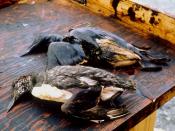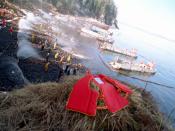Page 1
SCIE 131 Assignment 6-1
The Exxon Valdez Incident
On March 24, 1989 the Exxon Valdez ran aground on Bligh Reef in Prince William Sound. The oil tanker had encountered icebergs and steered out of the shipping lanes to avoid them. Captain Hazelwood had given Third Mate Gregory Cousins instructions on when and where to steer back into the shipping lanes. It is still unclear why the turn back to the shipping lane was not made. Extensive investigation by the National Transportation Safety Board (NTSB) revealed several contributing factors:
1. The failure of the third mate to properly maneuver the vessel, possibly due to fatigue and excessive workload;
2. The failure of the master to provide a proper navigation watch, possibly due to impairment from alcohol;
3. The failure of Exxon Shipping Company to supervise the master and provide a rested and sufficient crew for the Exxon Valdez;
4. The failure of the U.S. Coast Guard to provide an effective vessel traffic system
5. The lack of effective pilot and escort services.
Regardless how it occurred the Exxon Valdez accident was the most publicized and investigated oil spill in history (Oil Spill Facts).
Eight of the tankers eleven cargo tanks were ruptured spilling an estimated 11 million gallons of crude oil into the sea and contaminating over 1000 miles of Alaska's coastline. Because Exxon was unprepared for such a disaster the spill control and clean up response was slow. This allowed the oil to travel and spread over a very large area. Skimmers were used to try to contain and extract the crude oil from the surface. There was only 4000 gallons of dispersant agent available in Valdez, Alaska and no equipment to apply it. A
Page 2
helicopter was sent in to spray a dispersant agent over the...


